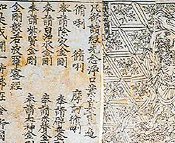11 October 2003
Public Design, Year 868
From Democracy and Its Global Roots, by Amartya Sen:
 “In the subject of public discussion and communication, it is also important to note that nearly every attempt at early printing in China, Korea, and Japan was undertaken by Buddhist technologists, with an interest in expanding communication. The first printed book in the world was a Chinese translation of an Indian Sanskrit treatise, later known as the ‘Diamond Sutra,’ done by a half-Indian and half-Turkish scholar called Kumarajeeva in the fifth century, which was printed in China four and half centuries later, in 868 C.E. The development of printing, largely driven by a commitment to propagate Buddhist perspectives (including compassion and benevolence), transformed the possibilities of public communication in general. Initially sought as a medium for spreading the Buddhist message, the innovation of printing was a momentous development in public communication that greatly expanded the opportunity of social deliberation.
“In the subject of public discussion and communication, it is also important to note that nearly every attempt at early printing in China, Korea, and Japan was undertaken by Buddhist technologists, with an interest in expanding communication. The first printed book in the world was a Chinese translation of an Indian Sanskrit treatise, later known as the ‘Diamond Sutra,’ done by a half-Indian and half-Turkish scholar called Kumarajeeva in the fifth century, which was printed in China four and half centuries later, in 868 C.E. The development of printing, largely driven by a commitment to propagate Buddhist perspectives (including compassion and benevolence), transformed the possibilities of public communication in general. Initially sought as a medium for spreading the Buddhist message, the innovation of printing was a momentous development in public communication that greatly expanded the opportunity of social deliberation.
The commitment of Buddhist scholars to expand communication in secular as well as religious subjects has considerable relevance for the global roots of democracy. Sometimes the communication took the form of a rebellious disagreement. Indeed, in the seventh century Fu-yi, a Confucian leader of an anti-Buddhist campaign, submitted the following complaint about Buddhists to the Tang emperor (almost paralleling the current official ire about the ‘indiscipline’ of the Falun Gong): ‘Buddhism infiltrated into China from Central Asia, under a strange and barbarous form, and as such, it was then less dangerous. But since the Han period the Indian texts began to be translated into Chinese. Their publicity began to adversely affect the faith of the Princes and filial piety began to degenerate. The people began to shave their heads and refused to bow their heads to the Princes and their ancestors.’ In other cases, the dialectics took the form of learning from each other. In fact, in the extensive scientific, mathematical, and literary exchanges between China and India during the first millennium C.E., Buddhist scholars played a major part.”
Accordingly, the ‘Diamond Sutra’ scroll was dedicated to the public domain. From The Invention of Printing in China, by Thomas Carter, 1955:
“The book consists of six sheets of text and one shorter sheet with woodcut, all neatly pasted together so as to form one continuous roll sixteen feet long... At the end, printed into the text, is the statement that the book was ‘reverently made for universal free distribution by Wang Chieh on behalf of his two parents on the 15th of the 4th moon of the 9th year of Hsien-t’ung.’”
via Three-Toed Sloth and Lawrence Lessig
![]() 11 October 2003, 4:20 AM | LINK | Filed in
china, publishing
11 October 2003, 4:20 AM | LINK | Filed in
china, publishing
Read more items related by tag:

